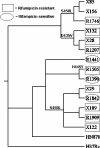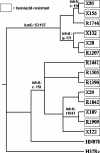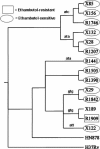The non-clonality of drug resistance in Beijing-genotype isolates of Mycobacterium tuberculosis from the Western Cape of South Africa
- PMID: 21110864
- PMCID: PMC3091785
- DOI: 10.1186/1471-2164-11-670
The non-clonality of drug resistance in Beijing-genotype isolates of Mycobacterium tuberculosis from the Western Cape of South Africa
Abstract
Background: The Beijing genotype of M. tuberculosis is a virulent strain that is disseminating worldwide and has a strong association with drug resistance. In the Western Cape of South Africa, epidemiological studies have identified the R220 cluster of the Beijing genotype as a major contributor to a recent outbreak of drug-resistant tuberculosis. Although the outbreak is considered to be due to clonal transmission, the relationship among drug resistant isolates has not yet been established.
Results: To better understand the evolution of drug resistance among these strains, 14 drug-resistant clinical isolates of the Beijing genotype were sequenced by whole-genome sequencing, including eight from R220 and six from a more ancestral Beijing cluster, R86, for comparison. While each cluster shares a distinct resistance mutation for isoniazid, mapping of other drug-resistance mutations onto a phylogenetic tree constructed from single nucleotide polymorphisms shows that resistance mutations to many drugs have arisen multiple times independently within each cluster of isolates. Thus, drug resistance among these isolates appears to be acquired, not clonally derived. This observation suggests that, although the Beijing genotype as a whole might have selective advantages enabling its rapid dissemination, the XDR isolates are relatively less fit and do not propagate well. Although it has been hypothesized that the increased frequency of drug resistance in some Beijing lineages might be caused by a mutator phenotype, no significant shift in synonymous substitution patterns is observed in the genomes.
Conclusion: While MDR-TB is spreading by transmission in the Western Cape, our data suggests that further drug resistance (i.e. XDR-TB) at this stage is acquired.
Figures









References
-
- Sreevatsan S, Pan X, Stockbauer KE, Connell ND, Kreiswirth BN, Whittam TS, Musser JM. Restricted structural gene polymorphism in the Mycobacterium tuberculosis complex indicates evolutionarily recent global dissemination. Proc Natl Acad Sci USA. 1997;94(18):9869–9874. doi: 10.1073/pnas.94.18.9869. - DOI - PMC - PubMed
-
- Manca C, Tsenova L, Bergtold A, Freeman S, Tovey M, Musser JM, Barry CE, Freedman VH, Kaplan G. Virulence of a Mycobacterium tuberculosis clinical isolate in mice is determined by failure to induce Th1 type immunity and is associated with induction of IFN-alpha/beta. Proc Natl Acad Sci USA. 2001;98(10):5752–5757. doi: 10.1073/pnas.091096998. - DOI - PMC - PubMed
Publication types
MeSH terms
Substances
LinkOut - more resources
Full Text Sources
Other Literature Sources
Molecular Biology Databases

